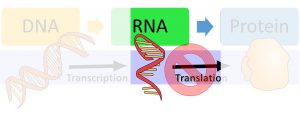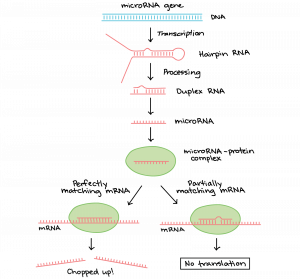20 Protein Synthesis III: RNA Interference
Andrea Bierema
Learning Objectives
Students will be able to:
- Describe the process of RNA interference.
- Compare the two types of RNA interference: microRNA and siRNA.
- Explain how RNA interference affects gene expression.

Recent Discovery
Not all RNA molecules code for protein. Some RNA control genes in a way that was only discovered recently: a process called RNA interference, or RNAi. Although scientists identified RNAi relatively recently, they now know that organisms have been using this trick for millions of years.
RNAi is a mechanism that organisms use to silence genes when the proteins that they code for are no longer needed. This silencing happens when short RNA molecules bind to stretches of mRNA, preventing translation of the mRNA.
Click on the “plus” hotspots in the figure below to learn more!
(credit: modification of work by Robinson, R)
Researchers believe that RNAi arose as a way to reduce the production of a gene’s encoded protein for purposes of fine-tuning growth or self-defense. When viruses infect cells, for example, they command their host to produce specialized RNAs that allow the virus to survive and make copies of itself. Researchers believe that RNAi eliminates unwanted viral RNA and some speculate that it may even play a role in human immunity.
Oddly enough, scientists discovered RNAi from a failed experiment! Researchers investigating genes involved in plant growth noticed something strange: when they tried to turn petunia flowers purple by adding an extra “purple” gene, the flowers bloomed white instead.
This result fascinated researchers, who could not understand how adding genetic material could somehow get rid of an inherited trait. The mystery remained unsolved until, a few years later, two geneticists studying development saw a similar thing happening in lab animals.
The researchers, Andrew Z. Fire (then of the Carnegie Institutions of Washington in Baltimore and now at Stanford University) and Craig Mello (of the University of Massachusetts Medical School in Worcester) were trying to block the expression of genes that affect cell growth and tissue formation in roundworms, using a molecular tool called antisense RNA.
To their surprise, Mello and Fire found that their antisense RNA tool wasn’t doing much at all. Rather, they determined, a double-stranded contaminant produced during the synthesis of the single-stranded antisense RNA interfered with gene expression. Mello and Fire named the process RNAi (RNA interference) and in 2006 were awarded the Nobel Prize in Physiology or Medicine for their discovery.
Further experiments revealed that the double-stranded RNA gets chopped up inside the cell into much smaller pieces that stick to mRNA and block its action. That is, the mRNA cannot bind to a ribosome and translation cannot occur.
Today, scientists are taking a cue from nature and using RNAi to explore biology. They have learned, for example, that the process is not limited to worms and plants, but operates in humans too.
Medical researchers are currently testing new types of RNAi-based drugs for treating conditions such as macular degeneration (the leading cause of blindness) and various infections (including those caused by HIV and the herpes virus).
RNA Types
There are two main types of RNA that can interfere with mRNA and translation: microRNA and siRNA. This section describes microRNA in more detail. Watch the video in the next section to learn how microRNA and siRNA compare.
Molecules called microRNAs have been found in organisms as diverse as plants, worms, and people. The molecules are truly “micro,” consisting of only a few dozen nucleotides, compared to typical human mRNAs that are a few thousand nucleotides long.
What’s particularly interesting about microRNAs is that many of them evolved from DNA that used to be considered merely filler material. (14)
How do these small, but important, RNA molecules do their work? They start out much bigger but get trimmed by cellular enzymes including one aptly named Dicer. Like tiny pieces of Velcro®, microRNAs stick to certain mRNA molecules and stop them from passing on their protein-making instructions.
First discovered in a roundworm model system, some microRNAs help determine the organism’s body plan. In their absence, very bad things can happen. For example, worms engineered to lack a microRNA called let-7 develop so abnormally that they often rupture and practically break in half as the worm grows.
Perhaps it is not surprising that because microRNA helps specify the timing of an organism’s developmental plan, the appearance of the microRNAs themselves is carefully timed inside a developing organism. Biologists (including Amy Pasquinelli of the University of California, San Diego) are currently figuring out how microRNAs are made and cut to size, as well as how they are produced at the proper time during development.
MicroRNA molecules also have been linked to cancer. For example, Gregory Hannon of the Cold Spring Harbor Laboratory on Long Island in New York found that certain microRNAs are associated with the severity of the blood cancer B-cell lymphoma in mice.
Since the discovery of microRNAs in the first years of the 21st century, scientists have identified hundreds of them that likely exist as part of a large family with similar nucleotide sequences. New roles for these molecules are still being found.
Mechanisms
Watch the following video to learn about how the two main types of molecules used in RNAi (microRNA and siRNA) differ from one another and how they work to prevent (or interfere with) gene expression.
For closed captioning or to view the full transcript see the video on YouTube. Or click on the “YouTube” link in the video.
Exercise
After watching the video, answer the following question:
What happens after the microRNA binds to the mRNA?

The miRNA directs the protein complex to “matching” mRNA molecules (ones that form base pairs with the miRNA). When the RNA-protein complex binds.2
-
If the miRNA and its target match perfectly, an enzyme in the RNA-protein complex will typically chop the mRNA in half, leading to its breakdown.
-
If the miRNA and its target have some mismatches, the RNA-protein complex may instead bind to the mRNA and keep it from being translated.
These are not the only ways that miRNAs inhibit the expression of their targets and scientists are still investigating their many modes of action.3
Overview Interactive
For a review of what you learned in this chapter, see HHMI Biointeractive’s RNA Interference interactive!
References
-
Carthew, R. W. and Sontheimer, E. J. (2009). Origins and mechanisms of miRNAs and siRNAs. Cell, 136(4), 648. http://dx.doi.org/10.1016/j.cell.2009.01.035.
- Sayed, Danish and Abdellatif, Maha. (2011). MicroRNAs in development and disease. Physiological Reviews 91(3), 831, 837-839.
Attributions
This chapter is a modified derivative of the following articles:
“Cells 101: Business Basics” by U.S. Department of Health and Human Services, National Institutes of Health and National Institute of General Medical Sciences, Inside the Cell, Public Domain.
“The New Genetics” by U.S. Department of Health and Human Services, National Institutes of Health and National Institute of General Medical Sciences, Inside the Cell, Public Domain.
“Whole Genome Methods and Pharmaceutical Applications of Genetic Engineering” by OpenStax College, Biotechnology Foundations 2nd Edition, CC BY 4.0. Download the original article for free at https://cnx.org/contents/XcbB5HTY@5.10:5a_R7R3y@4/Pharmaceutical-Applications-of-Genetic-Engineering
“Regulation after Transcription.” by Khan Academy, CC BY-NC-SA 4.0. Download the original article for free at https://www.khanacademy.org/science/biology/gene-regulation/gene-regulation-in-eukaryotes/a/regulation-after-transcription

